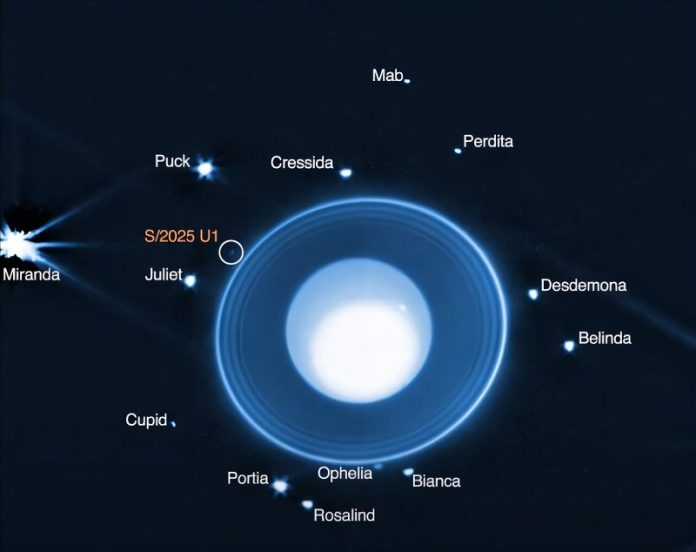
The James Webb Space Telescope has just made a remarkable discovery: a brand-new moon orbiting Uranus.
This tiny object, only about six miles (10 kilometers) across, is the latest addition to the planet’s growing family of satellites. With this find, Uranus is now known to host 29 moons.
The discovery was made on February 2, 2025, by a team led by the Southwest Research Institute (SwRI).
The faint moon was detected using Webb’s powerful Near-Infrared Camera (NIRCam), which took a series of ten long-exposure images, each lasting 40 minutes.
“This is a small moon, but an important one,” explained lead scientist Maryame El Moutamid from SwRI’s Solar System Science and Exploration Division. “Even Voyager 2, which flew past Uranus nearly 40 years ago, didn’t spot it. That shows how advanced Webb’s instruments really are.”
The reason this moon went unnoticed until now is its size.
At just six miles wide, it is far smaller and fainter than Uranus’s other inner moons, which makes it almost invisible to older telescopes. Scientists believe that its discovery hints at even more moons waiting to be found around Uranus.
“No other planet has as many tiny inner moons as Uranus,” said Matthew Tiscareno of the SETI Institute, a member of the research team. “Their interactions with the rings suggest a chaotic past that blurs the line between what we call a moon and what we call a ring.”
This newly discovered moon orbits about 35,000 miles (56,000 kilometers) from Uranus’s center.
It sits between two other small moons: Ophelia, which lies just outside the planet’s main ring system, and Bianca. Its nearly circular orbit suggests that it likely formed close to where it is today, rather than being captured later from elsewhere in the solar system.
For now, the moon does not yet have an official name. Following tradition, Uranus’s moons are named after characters from the works of Shakespeare and the poet Alexander Pope. The International Astronomical Union (IAU) will eventually choose its designation.
This discovery was made as part of Webb’s General Observer program, which allows scientists around the world to propose research projects. The telescope’s combination of high resolution and infrared sensitivity is what made it possible to detect such a faint and distant object.
For astronomers, this find is a reminder of how far space exploration has come since Voyager 2’s historic flyby of Uranus on January 24, 1986.
That mission gave humanity its first close-up look at the pale blue giant. Now, nearly four decades later, Webb is carrying the torch forward, uncovering new secrets about a planet that still holds many mysteries.
As El Moutamid put it, “This discovery shows that the outer solar system still has plenty of surprises in store. With Webb, we’re seeing Uranus in a way that was never possible before.”



